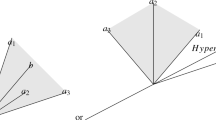Abstract
The simplex method for linear programming can be extended to permit the minimization of any convex separable piecewise-linear objective, subject to linear constraints. This three-part paper develops and analyzes a general, computationally practical simplex algorithm for piecewiselinear programming.
Part I derives and justifies the essential steps of the algorithm, by extension from the simplex method for linear programming in bounded variables. The proof employs familiar finite-termination arguments and established piecewise-linear duality theory.
Part II considers the relaxation of technical assumptions pertaining to finiteness, feasibility and nondegeneracy of piecewise-linear programs. Degeneracy is found to have broader consequences than in the linear case, and the standard techniques for prevention of cycling are extended accordingly.
Part III analyzes the computational requirements of piecewise-linear programming. The direct approach embodied in the piecewise-linear simplex algorithm is shown to be inherently more efficient than indirect approaches that rely on transformation of piecewise-linear programs to equivalent linear programs. A concluding section surveys the many applications of piecewise-linear programming in linear programming,l 1 estimation, goal programming, interval programming, and nonlinear optimization.
Similar content being viewed by others
References
I. Barrodale and F.D.K. Roberts, “An improved algorithm for discreteL 1 linear approximation”,SIAM Journal on Numerical Analysis 10 (1973) 839–848.
R.H. Bartels, “A penalty linear programming method using reduced-gradient basis-exchange techniques”,Linear Algebra and Its Applications 29 (1980) 17–32.
A. Charnes and W.W. Cooper, “Nonlinear power of adjacent extreme point methods in linear programming”,Econometrica 25 (1957) 132–153.
A. Charnes, W.W. Cooper and R.O. Ferguson, “Optimal estimation of executive compensation by linear programming”,Management Science 1 (1955) 138–151.
A. Charnes and C.E. Lemke, “Minimization of non-linear separable convex functionals”,Naval Research Logistics Quarterly 1 (1954) 301–312.
A.R. Conn, “Linear programming via a nondifferentiable penalty function”,SIAM Journal on Numerical Analysis 13 (1976) 145–154.
G.B. Dantzig, “Recent advances in linear programming”,Management Science 2 (1956) 131–144.
G.B. Dantzig, S. Johnson and W. White, “A linear programming approach to the chemical equilibrium problem”,Management Science 5 (1958) 38–43.
M. Davies, “Linear approximation using the criterion of least total deviations”,Journal of the Royal Statistical Society (series B) 29 (1967) 101–109.
R. Fourer, “Notes on ‘semi-linear’ programming”, informal report, Department of Industrial Engineering and Management Sciences, Northwestern University (Evanston, IL, 1981).
R. Fourer, “A simplex algorithm for piecewise-linear programming II: Finiteness, feasibility and degeneracy”, Technical report 85-03, Department of Industrial Engineering and Management Sciences, Northwestern University (Evanston, IL, 1985).
R. Fourer, “A simplex algorithm for piecewise-linear programming III: Computational analysis and applications”, in preparation.
J.K. Ho, “Relationship among linear formulations of separable convex piecewise linear programs”, Technical report, College of Business Administration, University of Tennessee (Knoxville, TN, 1984). To appear inMathematical Programming Studies.
H.M. Markowitz and A.F. Perold, “Sparsity and piecewise linearity in large portfolio optimization problems”, in: I.S. Duff, ed.,Sparse matrices and their uses (Academic Press, New York, 1981) pp. 89–108.
A.F. Perold, “Large-scale portfolio optimization”,Management Science 30 (1984) 1143–1160.
A. Premoli, “Piecewise linear programming: The compact (CPLP) algorithm”, Technical report, Gruppo Sistemi e Circuiti, Istituto Elletrotecnico Nazionale Galileo Ferraris (Torino, Italy, 1982).
R.T. Rockafellar, “Convex programming and systems of elementary monotonic relations”,Journal of Mathematical Analysis and Applications 19 (1967) 543–564.
R.T. Rockafellar, “Monotropic programming: Descent algorithms and duality”, in: O. Mangasarian et al., eds.,Nonlinear programming 4 (Academic Press, New York, 1981) pp. 327–365.
R.T. Rockafellar,Network flows and monotropic optimization (Wiley-Interscience, New York, 1984).
R.D. Snyder, “Programming with piecewise-linear objective functions”, Working paper 9/81, Department of Econometrics and Operatibns Research, Monash University (Clayton, Victoria, Australia, 1981).
R.D. Snyder, “Linear programming with special ordered sets”,Journal of the Operational Research Society 35 (1984) 69–74.
K. Spyropoulos, E. Kiountouzis and A. Young, “Discrete approximation in theL 1 norm”,The Computer Journal 16 (1973) 180–186.
P. Wolfe, “The composite simplex algorithm”,SIAM Review 7 (1965) 42–54.
Author information
Authors and Affiliations
Additional information
This research has been supported in part by the National Science Foundation under grant MCS-8217261.
Rights and permissions
About this article
Cite this article
Fourer, R. A simplex algorithm for piecewise-linear programming I: Derivation and proof. Mathematical Programming 33, 204–233 (1985). https://doi.org/10.1007/BF01582246
Received:
Revised:
Issue Date:
DOI: https://doi.org/10.1007/BF01582246




